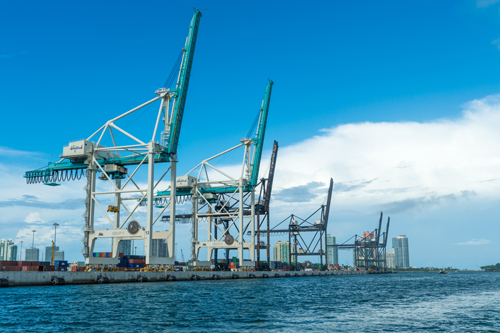
Mother Nature has shown time and again that she possesses the power to both amaze and terrify in equal measure. Nevertheless, what we have also seen on numerous occasions in the past is that mankind has the ability to take the most disastrous of events and turn them into something positive.
Such an event occurred in the early 1900s in the south-eastern United States, when a particularly powerful hurricane struck the city of Miami. Such was the devastating force of this storm that it split the southern end of Miami Beach, creating what would become known as the Government Cut shipping channel and Fisher Island.
Shortly after the hurricane the cut was dredged creating new access to the mainland through what became known as the Main Channel. This ultimately led to a huge improvement in shipping access to the existing port. In the decades that followed the port grew in size as shipping access continued to improve and the South Florida community expanded in size and range.
It was on 5 April, 1960, that the Dade County Board of Commissioners approved Resolution No. 4830, "Joint Resolution Providing for Construction of Modern Seaport Facilities at Dodge Island Site", which was subsequently approved by the City of Miami the following day. It was this landmark event that gave way to the construction of the new Port of Miami.
Construction of the new port, located on the artificially created Dodge Island, began shortly thereafter with the island itself also being expanded and linked to others in the general vicinity. The undertaking itself was a massive task, one that involved the construction of new seawalls, transit sheds, administrative buildings and a new vehicle and railroad bridge.
Today, PortMiami, as it is now officially known, is recognised as one of the busiest container ports in the United States. Accounting for more than 207,000 jobs and with an annual economic impact in Miami of some $27 billion, the port is also referred to in the maritime sector as the “Cruise Capital of the World”, with one in seven of all the world’s cruise passengers starting their journeys at the port. Indeed, in 2010 a record 4.33 million passengers travelled through the port.
For well over two decades the port has retained its status as the number one cruise/passenger port in the world, accommodating the largest cruise ships in the world and the operations of many of the world’s largest lines including Carnival, Royal Caribbean and Norwegian Cruise Line. In catering for such visitors the port currently operates eight passenger terminals, six gantry crane wharves, seven Ro-Ro docks, four refrigerated yards for containers, break bulk cargo warehouses and nine gantry container handling cranes.
Retaining its competitive edge as a world-class port has not been an easy task for PortMiami and has required considerable investment over the years. In 1997 the port underwent a comprehensive redevelopment programme at a cost of more than $250 million.
As part of the programme, new ultramodern cruise terminals, roadways and parking garages were constructed. Additionally, a new gantry crane dock and container storage yards were introduced along with the electrification of the gantry crane docks to include the conversion of several cranes.
In addition, the Port acquired two state-of-the-art super post-panamax gantry cranes which are amongst the largest in the world and are able to load and unload 22 container (8 foot wide each), or nearly 200 foot, wide mega container ships. This development will contribute towards making it possible for PortMiami to facilitate even the future largest containerships in the world, the Maersk Triple E Class.
As we look at PortMiami today there are several major infrastructure projects relating to the port which are all scheduled to be complete by 2014. These include the Port of Miami Tunnel, the Port of Miami Deep Dredge Project and the restoration of the bridge and rail line connecting the port to the mainland.
Construction on the Miami Port Tunnel, a $1 billion project that will connect the port to other major highway arteries began in May, 2010. Meanwhile, the Port of Miami Deep Dredge project is one of considerable importance, seeing as its construction will allow Super Post-Panamax Megaships to enter the United States after the completion of the Panama Canal expansion in 2014.
With the correct funding, the Port of Miami estimates that it is capable of completing such a project by 2014. It is also estimated that this project could double Miami's cargo business in the next ten years as well as creating over 30,000 permanent jobs for the city.
Written by Will Daynes, research by Adam Kalynuk
DOWNLOAD
 PortMiami-AM-T&L-Oct13-Bro-s.pdf
PortMiami-AM-T&L-Oct13-Bro-s.pdf













